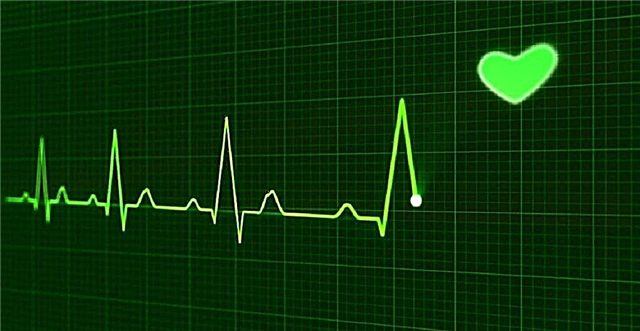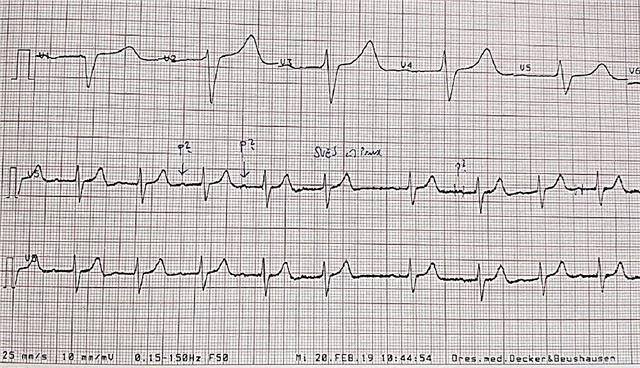ECG decoding
For the first time, the method of cardiography was applied at the beginning of the 19th century. At this time, scientists figured out that heart impulses could be recorded on paper using the then invented cardiograph. But this process took too long.
Normal indicators in children
The electrocardiogram is a linear graphical form that expresses indicators of the size of the teeth and the duration of the phases of the cardiac cycle. ECG decoding requires a careful analysis of all values.
Heart rhythm - this is one of the most important components in the work of the heart.
The main muscle of the body works without interruption and creates a sinus rhythm. This rhythm is due to the beating of the heart in equal shares of time - seconds. In case of heart rhythm disturbances, arrhythmia occurs.
Conductivity - the ability of the heart to conduct impulses from the sinus node to the myocardium. The heart is shrouded in nerve fibers that send electrical impulses.
Teeth, ECG segments

As we have already found out, the ECG is a linear straight line, which displays the indicators of the heart. On this line we see "mounds", which are called teeth. There are only five of them and they are designated by Latin letters - P, q, r, s, t.
The first wave that rises above the line is the P wave. It reflects the beginning of the atria.
Depolarization of the heart is a process that reflects the excitement or activation of the heart muscle. Repolarization is the process of relaxation of the heart muscle.
Thus, the P wave reflects the process of depolarization of the right and left atrium.
The next wave is Q. It tells us about the excitation of the middle part of the interventricular septum. The area from the P wave to the Q wave is called a segment. The segment reflects the spread of excitation along the nerve fibers of the heart.
R wave - depolarization of the walls of the left and right ventricles.
S wave - excitement of the ventricles and interventricular septum.
The ST segment is the time of full coverage of the excitation of the ventricular myocardium.
The T wave characterizes the repolarization of the ventricular myocardium.
The ECG film in each lead must have at least 4 cardiac complexes.
Informative value of ECG in children and adolescents
ECG is a diagnostic method that allows you to register changes in electrical potentials that occur in the heart muscle.
ECG decoding consists in recording action potentials emanating from cardiomyocytes (heart cells) on paper or film using special electrodes. We see all this “magic” in the form of the curve and the teeth described above.
The heart is a unique organ that contains nerve fibers, has one of the strongest muscles in the body - the myocardium, and contracts 2.5 billion times in a lifetime, just think about it.
What are leads?
Standard leads record the potential difference between the limbs. There are only three of them and are designated by Roman numerals. The electrodes of the cardiograph have different colors - red, yellow, green and are attached to the limb.
There is also such a thing as chest leads, which record the same potential difference between the electrodes on the chest (in the form of suction cups) and the combined electrode from three limbs. Chest leads 6.
Indications for referring a child to an ECG
- Appearance of complaints about:
- heart palpitations, both during exercise and at rest;
- fainting;
- the appearance of shortness of breath at rest;
- the appearance of pain in the heart;
- frequent respiratory diseases, pneumonia, bronchitis;
- swelling.
- When visiting sports clubs, swimming.
- During auscultation, "pathological" heart murmurs are heard.
- Before any surgical intervention.
An ECG can be sent not only by a cardiologist, but also by a doctor of any other specialty.
Preparing for an ECG study
First of all, if we are talking about a child, then he must be mentally prepared for this procedure. You need to start with the fact that the child needs to be explained that he will not be hurt, and he will cope with everything.
Before the examination, it is advisable not to eat anything for at least 2 hours, you can drink.
During the examination, the child should be calm, but not everyone succeeds.
So that the child is not afraid and does not cry during the ECG, you need to take your favorite toy with you, play with him at home as a doctor and a patient. It is also desirable to carry out the examination with the mother of the child. Remember, if the child is as calm as possible, the doctor will be able to obtain the most reliable information.
If we talk about adults, then before the examination, you do not need to drink alcohol at least a day, caffeine-containing drinks. Smoking should be excluded two hours before the examination. It is also better to remove all jewelry in the form of chains, bracelets.
For convenience, you should wear comfortable clothes so that it is not problematic to take them off.
Basic rules for recording an ECG
- The ECG is taken in a supine position after 15 minutes of rest.
- The limb electrodes are attached tightly to the forearms and legs. In order to reduce the electrical resistance of the skin at the points of attachment of the electrodes, a cloth moistened with sodium chloride is applied to it.
- The electrocardiograph must be functional and grounded.
- The study room must be warm. ECG is best done on a wooden trestle bed.
- Cell phones and other gadgets are not allowed in clothing pockets.
- The breast electrodes are attached to the suction cups.
- ECG recording in children is carried out in the same places as in adults, but the electrodes are slightly smaller in size, depending on age.
If the baby does not want to lie, then it is allowed to sit down on his mother's knees and remove the film while sitting.
Features of performing an ECG for children
As mentioned above, the child needs to be prepared by explaining to him that this research is necessary and painless. Make an examination in the form of a game, using toys to distract the child's attention.
Mothers should note that the electrodes should be smaller than those of adults. If this is not the case, then the objectivity of the survey will be in question.
| Electrodes for feet, hands | Breast electrodes | |
| Up to 3 x. months | 30 * 20mm | 10 mm |
| Up to 1 year | 35 * 25mm | 15 mm |
| Up to 3 years | 40 * 30mm | 20 mm |
| Up to 8 years | 45 * 35mm | 25 mm |
The ECG is also recorded in 12 leads. The locations are the same as for adults.
Children's features of the electrocardiogram
- A small child cannot control his emotions, so sinus or respiratory arrhythmias can often be seen on the ECG.
- Very often, due to the growth of the heart, incomplete blockade of the right bundle branch can occur.
- In children of the first six months of life, the right heart is predominant, therefore, often, especially on the ECG of newborns, we can see an overload of the right atrium or ventricle.
- The master pacemaker can move along the right atrium, hence the term pacemaker migration.
- The smaller the child, the shorter the ECG intervals. This is due to the faster conduction of excitation through the conducting system of the myocardium due to the smaller size of the heart.
- The heart rate decreases with age.
- Also, at the age points of intensive growth (5-6 years old, 12-13 years old), bradycardia may occur.
What ECG indicators are alarming?
- First of all, the doctor looks at the heart rhythm on the ECG tape. It can be slowed down - bradycardia or more frequent - tachycardia. Bradycardia is determined when the heart rate is less than 60. But, as mentioned above, this may be a child's feature. If bradycardia on the ECG has been observed for several years in a row and progresses, you need to think about it.
- Hypertrophy of the heart chambers - when the QRS wave complex changes. This can tell us about the presence of congenital heart defects, inflammatory changes in the membranes of the heart.
- All kinds of heart blockages. But it should be borne in mind that an incomplete blockade requires observation at the initial stages of its detection.
- Extraordinary contractions of the heart or extrasystoles. Here you should also remember about the presence of non-cardiac diseases - helminthic invasion, chronic ENT diseases, even gastritis.
- Tachycardia - may be associated with excessive excitement during the examination. But if in ordinary life there are attacks of sudden heartbeat in a calm state, you should inform your doctor about this.
What additional examinations are necessary, and for what diagnoses?
The most basic examinations associated with cardiac diseases are echocardioscopy (ultrasound of the heart) and 24-hour ECG monitoring (CMECG). These examinations must be carried out under the following conditions:
- Bradycardia confirmed by multiple ECG examinations.
- Tachycardia, when palpitations occur at rest.
- Ventricular or atrial extrasystoles.
- Hypertrophy of the chambers of the heart.
- Complete blockades.
ECG norm and its deviations in adults

In adults, the ECG has the same essence as in children. But in adults, there are diseases such as myocardial infarction, coronary heart disease.
An ECG in an adult has the following features:
- lower heart rate compared to children (60-80 per minute);
- the left heart is predominant;
- blockade - there is no ECG rate in adults;
- arrhythmias in the form of bradycardia are typical for athletes, in other categories of people it speaks of a violation of cardiac activity.
What can distort the ECG results?
Excessive excitement can distort the ECG results in the first place, especially in children. In infants, this is crying. All this will cause tachycardia, which the doctor will need to differentiate from the pathological condition.
Also, the ECG can be affected by the cold room where the examination is carried out.
Tea, coffee, smoking can also give a false picture of electrocardiography.
Before any heart examination, the doctor should be told what medications you are taking, especially cardiological medications. It is also advisable, if possible, not to take the pills at least two hours before the examination.
When do children need a routine ECG?
Since 2016, it has become compulsory to conduct an ECG for children in the first year of life, and if there is a suspicion of a violation of cardiac activity, and a newborn child.
Children who are engaged in the sports section must undergo an ECG once a year.
Children who enter kindergartens and schools will also be required to undergo this procedure on the medical board.

Conclusion
In conclusion, I would like to say that cardiography is an absolutely painless and fairly quick procedure, but at the same time, according to its results, you can find out a lot about the work of the heart.



